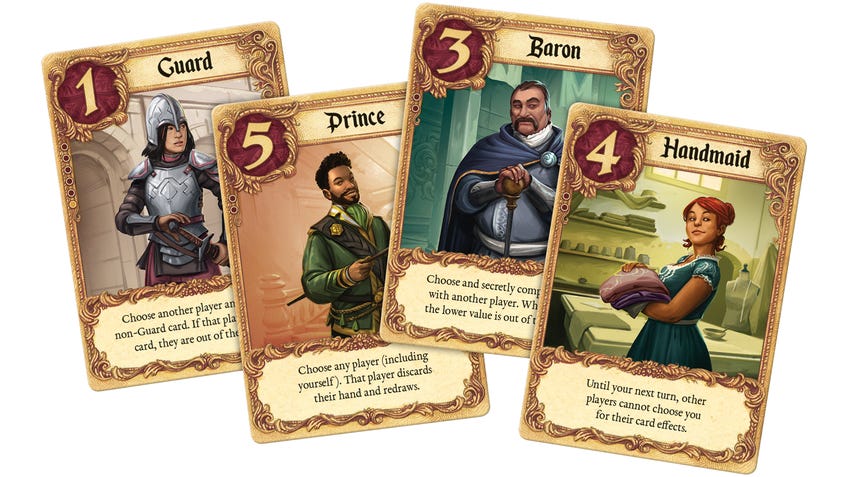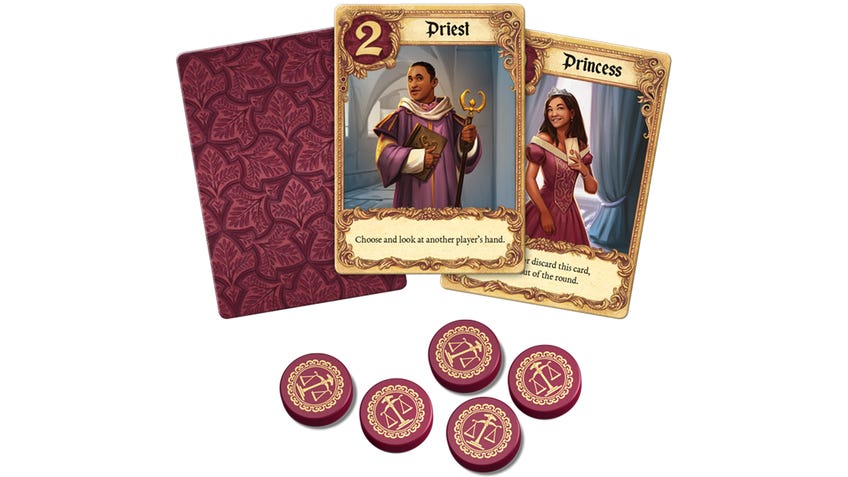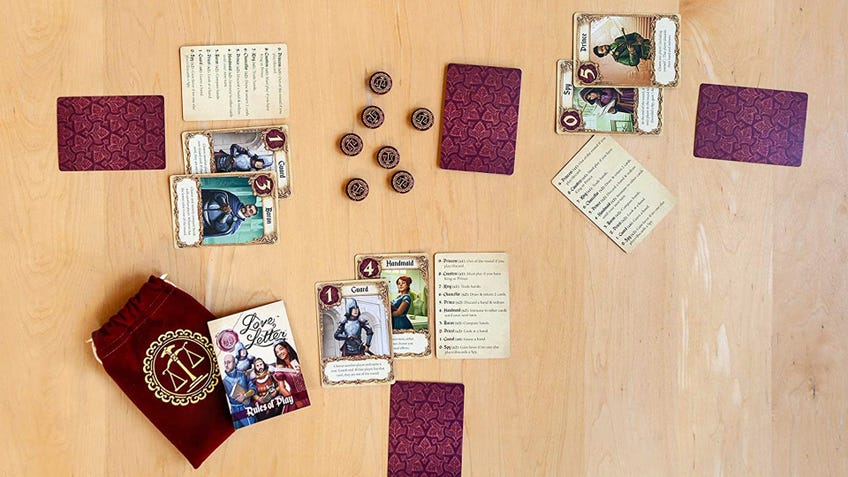How to play Love Letter: board game's rules, setup and how to win explained
Princess of Hearts.
Love Letter is a beautifully tiny card game by Seiji Kanai that sees players trying to woo a princess by getting their message as close to the sought-after royal as possible.
Released in 2012, Love Letter has become a firm favourite of many players thanks to its simple rules and fast, competitive gameplay. If you’re yet to experience this pocket-sized delight, read on to learn how to play Love Letter - once you know the rules, there’s a good chance you’ll soon be infatuated, too!
Queen Marianna has been arrested for high treason, and her daughter Princess Annette is heartbroken. Opportunistic suitors across the kingdom plan to ease the princess’ sorrow (and presumably benefit themselves) by courting her, but Annette has locked herself in the palace.
Players must see off competition from their rival admirers and get their love letter as close to the princess’ inner circle as possible - in the case of the game, eliminating their opponents by choosing their cards carefully.
Love Letter is ridiculously simple to learn and very fast to play. But in all its simplicity, there is a level of bluffing, reading people and their cards - and also a certain amount of sheer luck as to what you draw. With a deck made up of just 16 cards, you’ll be amazed at how much depth there is in the game once you really get your teeth into it.
How to play Love Letter
- Player count, game length and overview: What is Love Letter and how many people can play?
- Setup: Deal out cards as we prepare to play.
- Gameplay rules: Get ready to compete for the princess' affection as we run through a round of Love Letter.
- Love Letter card reference: Learn what each card does in Love Letter in one handy list.
- How does the Baron work in Love Letter?: Explaining one of the card's more confusing card abilities.
- End of the game and scoring: Count up your tokens and see who triumphs.
Aside from the original game, there are many other Love Letter editions available, all with slight variants to the base set of rules. Some of the best spin-offs include The Hobbit, Archer and the Premium edition - which will allow you to play with up to eight players and add many new characters, giving the game an extra level of depth.
Once you know the basics, you can easily pick up any of the variants and enjoy jostling with your opponents - whether it’s for love, money or anything else. Here’s how to play Love Letter.
Player count, game length and overview
Love Letter is a competitive card game for two to four players. It takes approximately 20 minutes to play, although individual rounds can take as little as five minutes and the game’s format means you can play for as many rounds or as long as you like.
In Love Letter, players take it in turns to draw and play one card, performing its unique ability in the hope of eliminating their opponents. The last player left in wins the round and claims an affection token - or, if the deck runs out, the player with the highest-value card takes the win. The player who wins a given number of affection tokens first wins the entire game.

Setup
Shuffle the deck of 16 cards. Deal one card to each player facedown.
Place the tokens of affection to the side.
Remove one card from the deck facedown and place it to the side. In a two-player game, you remove three cards and place them to the side face-up.
Place the remaining cards in the middle of the table for all to reach. This is the draw deck.
Deal one reference card to each player. The reference cards will show you each of the cards that are available in the game. The number on the left of the character’s name indicates the value of each card, the Princess being the highest-value at 8 and the Guard being the lowest at 1. The number in the brackets to the right of the characters name shows you how many of each of this card is in the game - so there is only one Princess but there are five Guards.
The reference card also tells you each card’s ability when played but in a shorthand form. More info can be read on each individual card or in the rulebook.
Gameplay rules
The starting player rule is for the last person who went on a date to go first - but if that doesn’t appeal to you, you can of course come up with your own way of choosing a starting player instead.
The first player draws a second card into their hand. They must now choose one to keep and one to discard. The card they discard will have their power activated.
You’ll be able to read each card’s power on the card itself or there is also a shorthand version on the reference card each player has.
The game will last over several rounds with the aim of each round being either to be the last player remaining by knocking out other players OR to have the highest value card left in your hand by the end of the round.
The round ends when there are no more cards in the draw deck in the middle of the table.

The person who wins the round receives a token of affection. Now you shuffle all the cards back together (don’t forget about any you placed to the side at the beginning) and set up a new round.
If there is ever a draw for highest-value card at the end of a round, the person whose discarded cards add up to a higher value wins.
Once you get to know the cards and their abilities, the game becomes a very fast-paced affair.
Any time a card is discarded, it will lay face-up in front of the player who played it. This means card counting becomes easier as the game moves on and there are fewer cards available.
You will also become more familiar with the most likely card combination plays. For example, if someone plays a Countess, it is likely that the card left in their hand is either a Prince, a King or a Princess.
If someone plays a King, it’s very likely that they’ve just handed their Princess over to someone else - because most people won’t play a King unless a Princess forces them to.
Love Letter card reference
These are the unique abilities that each Love Letter card performs when played on your turn, alongside the cards’ values and the number of cards in the standard Love Letter deck.
- 8 - Princess: You are immediately eliminated if you discard the Princess. At the end of the round, the Princess is the highest-value card. (1 card)
- 7 - Countess: You must discard the Countess if the King or Prince is the other card in your hand. The Countess can be discarded normally without effect or kept if the card in your hand is another card. (1 card)
- 6 - King: Swap the remaining card in your hand with another player. (1 card)
- 5 - Prince: Force a player of your choice to discard the card in their hand. They do not perform the card’s action. (But if it’s the Princess, they are eliminated!) They immediately draw a new card. (2 cards)
- 4 - Handmaid: Card abilities do not affect you until your next turn. (2 cards)
- 3 - Baron: Compare the value of the remaining card in your hand with an opponent’s card. The player with the lower-value card is eliminated. (2 cards)
- 2 - Priest: Look at the card in another player’s hand. Only you see their card. (2 cards)
- 1 - Guard: Name an opponent and guess the card in their hand (other than a Guard). If you are correct, they are eliminated. They do not need to reveal their card if the guess is incorrect. (5 cards)

How does the Baron work in Love Letter?
There’s one card ability in Love Letter that many players get confused by when they first get to know the game - the Baron.
The Baron has a card value of 3, and there are two of them in the game. The Baron’s ability states that you must compare your hand with another player’s and the lowest-value card is out.
When you play the Baron, you do not compare the Baron with someone else’s card; you compare what’s left in your hand with someone else. So if you play the Baron and have a Countess left in your hand, and the card is your opponent’s hand is lower than the Countess’ value of 7, they are knocked out for the round.
If you play the Baron and it turns out you and the player you have chosen have the same value card (for example, you both reveal a Prince), nothing happens and play continues to the next player.
End of the game and scoring
Love Letter ends when one player has a certain number of affection tokens from the Princess; she’s now read so many of your letters, she’s become enamored by you.
The number of tokens you need to win is dependent on how many players are playing. You’ll need seven in a two-player game, five for three players and four tokens when there are four people playing.


